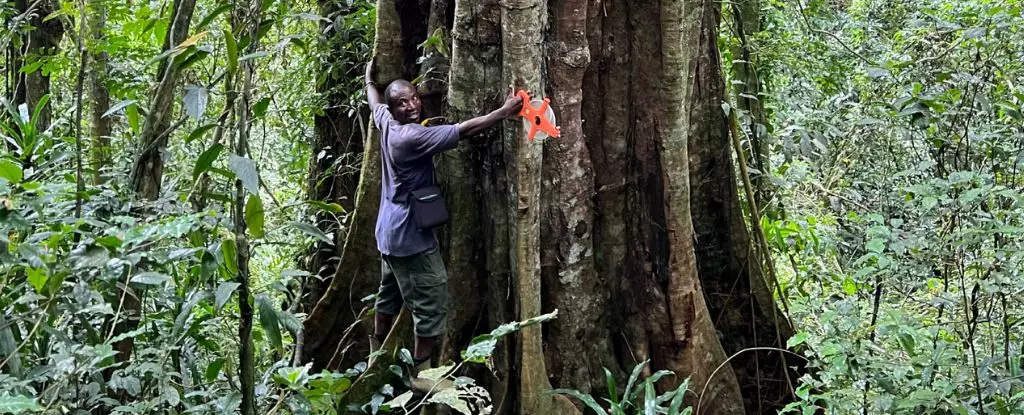In the heart of Tanzania’s Udzungwa Mountains, scientists have uncovered a botanical treasure, a species that shatters our understanding of longevity and biodiversity. Known as *Tessmannia princeps*, this towering tree has potentially been a silent witness to millennia of ecological history, living for possibly up to 3,000 years. The fact that a species of such prominence and age remained undiscovered until recently speaks volumes about our neglect and the ongoing degradation of these vital ecosystems. It compels us to reflect on how much of Earth’s biodiversity remains shrouded in obscurity, evading our scientific grasp while facing unprecedented threats from environmental changes.
Behind the Scientific Revelation
The story of *Tessmannia princeps* began with botanist Andrea Bianchi and his local counterparts, Aloyce and Ruben Mwakisoma, who serendipitously stumbled upon this majestic tree during their 2019 expedition. Standing at a staggering 40 meters tall, its superficial characteristics—mottled bark, sprawling root buttresses, and distinctly shaped leaves—set it apart from its botanical relatives. These features not only contribute to its individuality but also imply the complex evolutionary history embedded within its genetic makeup. The tree challenges the taxonomy of old-growth flora, pushing scientists to rethink classification and conservation tactics. What does it mean for a species to exist in such isolation, and what implications does this have for genetic diversity and resilience?
Conservation Under Siege
Despite its majestic stature, *Tessmannia princeps* is ensnared in a precarious battle for survival. Estimates suggest that only about 1,000 individuals remain, primarily confined to two nearby valleys. This raises a significant alarm: what can be done when such great ecological wonders are perched on the brink of extinction? A history of rampant deforestation paints a grim backdrop to the tree’s existence; much of its montane habitat has disappeared within the last century, retaliating against centuries of ecological stewardship by the earth.
Restoration efforts, driven by a private venture, aim to shield the remaining patches of forest while elevating the impoverished local communities. But these attempts, while commendable, remain fraught with difficulties and hurdles. Can monetary gain truly compete with the intrinsic value of an ecosystem? The deep intertwining of human development and environmental sustainability calls for urgent deliberation—if we don’t safeguard our ancient forests, we risk losing irreplaceable segments of our natural heritage.
The Ecosystem Bridge and Its Fragility
The existence of *Tessmannia princeps* is emblematic of a larger narrative: the critical ecosystem bridge it occupies connects two ancient forests that have persisted for around 30 million years. Beyond its aesthetic splendor, old-growth trees like the *Tessmannia* are pillars of the ecosystem, responsible for a plethora of vital services such as carbon sequestration, habitat provision, and moisture retention. Each tree acts as a carbon bank, absorbing CO2 and counteracting climate change—a service increasingly underappreciated in a world prioritizing short-term economic gain over long-term environmental health.
Yet the sad irony lies in the fact that the very trees instrumental in our survival face overwhelming endangerment. The planet’s old-growth forests are not just dwindling; they are being replaced by younger, less resilient trees, threatening the intricate web of life dependent on these elder statesmen of the forest. Statistics reveal that we lost nearly 4 million hectares of old-growth rainforest in 2018 alone—an area alarming enough to compare to an entire nation.
The Road Ahead: A Looming Crisis
The fate of *Tessmannia princeps* serves as a microcosm of the biodiversity crisis looming over our planet. As scientists predict that a staggering 75 percent of unidentified plant species face extinction, the alarming vulnerability of this newfound species cannot be overstated. Is it enough to label *Tessmannia princeps* as “vulnerable”? We have a dire need for decisive action, driven by a radical shift in how we view conservation—moving beyond categorization to proactive protective measures.
Humanity stands at a crossroads: we can choose to nurture our ecosystems and bolster conservation efforts that focus on biodiversity or we can continue on our current path—an avenue leading to inevitable ecological impoverishment. The survival of the *Tessmannia princeps*, a tree that may have withstood the flow of time, hinges upon our resolve to rectify our relationship with nature before it is too late. The question remains: will we have the courage to act, or will we be complicit in its extinction?


Leave a Reply